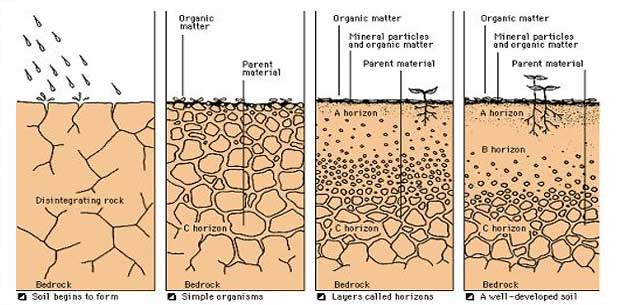Describe the Process of Soil Formation
The formation of true soil from Regolith The evolution of true soil from regolith takes place by the combined action of. Water wind temperature change gravity chemical interaction living organisms and pressure differences all help break down parent material.

Formation Of Soil Processes Of Soil Formation
Rocks are broken down into finer particles through many processes such as weathering and erosion.

. Simultaneously with weathering process pedogenesis or soil forming process also runs which leads weathered materials to develop into mature soil with well differentiated soil profiles and biological system. Denudation is the abrasion of present rock material by the action of ice water or wind. Acidic soil due to leaching of basic cations.
In this process parent material of soil is converted into soil in few steps. Parent material in converted into regolith. Soils form from the interplay of five main factors namely Parent Material Time Climate Relief and Organisms.
42 - Soil Forming Processes Additions. These four basic processes often referred as soil forming or Pedogenic processes. They are responsible of soil formation under all kind of environments.
Soil formation or pedogenesis is the process of evolution of soil under the influence of various physical biological climatic and geological factors. Soil formation occurs as a result of a gradual breakdown of rocks. Them in lakes and the ocean.
Soil formation occurs via a series of changes to the parent material all of which lead to the formation of layers of soil also called soil horizons. The weathering of rock R into Regolith 2. They are produced from rocks parent material through the processes of weathering and natural erosion.
Pedogenesis is the process of soil formation that is regulated by the effects of environment place and history. It is also termed as soil genesis. During soil formation the unconsolidated weathered material under goes many changes.
Plants dry out the soil. Through the movement of wind or water or uptake by plants soil particles sand silt clay and OM or. Structure forming processes Chemical processes.
Describe the process of soil formation. The geological components are mixed with organic materials to form soil. Ii The development or the formation of true soil by some soil forming factors and pedogenic processes.
O the layer of organic matter. Basic Processes of Soil Formation. The typically developed soil horizons as illustrated in Figure 516 are.
These processes lead to the. Adds little organic material each year due to no grass growth and decay. Soil formation involves the buildup of parent material the release of simple compounds the accumulation of organic matter the collection of humus from dead plants and the process of leaching.
The soil formation process depends upon the presence of new soil material which is either acquired by denudation or deposition. The first phase of soil formation ie. Soil is formed by the weathering of rocks.
Soil minerals form the basis of soil. Earthworms eat plant remains and mix them into the soil as they munch their way through the soil profile. Organic material iron and aluminium oxides and carbonates stabilise the aggregates through acting.
Weathering of soil can take place by. These changes are brought about by variations in the four-basic soil forming processes. It remains in place directly above and in contact with its parent rock.
Weathering process is nothing but the breaking of rocks into minute pieces. Hence it is a gradual process that takes years. The process of soil formation generally involves the downward movement of clay water and dissolved ions and a common result of that is the development of chemically and texturally different layers known as soil horizons.
Increase in mineral weathering. Materials added to the soil such as decomposing vegetation and organisms organic matter The total of the. The soils will carry the characteristics of its parent material such as color texture structure mineral composition and so on.
Due to these weathering rocks are formed. Pedogenesis or soil evolution formation is the process by which soil is formed. Weathering of parental rocks results in the development of several loose layers or horizons of weathered materials.
Weathering is considered as a destructive one and helps to change the consolidated rocks and minerals into unconsolidated material parent material whereas second phase of soil formation is considered as a constructive process and. Soil is formed by the process of weathering of rocks that is disintegration and decomposition of rocks and mineral at or near the earths surface through the actions of natural or mechanical and chemical agents into smaller grains. So Pedogenesis means the origin of soil.
Earth Sciences questions and answers. The soil formed directly from the chemical weathering process is called a residual soil. Soil is the outermost covering of earth but this thin covering is formed by a proper process which is called soil formation.
Deposition is the accumulation of new materials that have been eroded from another place such as river gravels or blown gravel or the creation of new rocks. Apsiganocj and 10 more users found this answer helpful. The document has moved here.
This process is illustrated in Figure 11. It refers to the mineral material or organic material from which the soil is formed. Rocks are broken into soildue to weathering the mountainous rocks are broken.
Factors Affecting Soil Formation. The soil is formed before millions and billions of years. Rainfall erodes some of this residual soil and transports it via streams and RESIDUAL SOIL-produced by physical and chemical.
Soil formation factors and processes The soil formation is the process of two consecutive stages. The force of wind water or glaciers mig ht have transported the soil to some other place. Dark A horizon but it will be shallow due to depth of root system.

Steps To Soil Formation Geology Humor Soil Soil Layers


Comments
Post a Comment